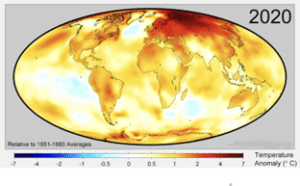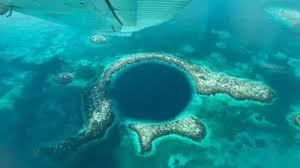Day-673
Quiz-summary
0 of 5 questions completed
Questions:
- 1
- 2
- 3
- 4
- 5
Information
DAILY MCQ
You have already completed the quiz before. Hence you can not start it again.
Quiz is loading...
You must sign in or sign up to start the quiz.
You have to finish following quiz, to start this quiz:
Results
0 of 5 questions answered correctly
Your time:
Time has elapsed
You have reached 0 of 0 points, (0)
Categories
- Not categorized 0%
- 1
- 2
- 3
- 4
- 5
- Answered
- Review
-
Question 1 of 5
1. Question
1. Consider the following statements:
Statement – I: The Arctic region is warming faster than any other region in the world.
Statement – II: The melting of ice cover in the Arctic exposes more water surface which has higher albedo.
Which one of the following is correct in respect of the above statements?Correct
Answer: C
Explanation: Statement-I is correct but Statement-II is incorrect
Heating of Arctic regions:
● Today carbon dioxide levels are near 420ppm and all greenhouse gases are rising rapidly due to the burning of fossil fuels, industrial processes, tropical forest destruction, landfills and agriculture.
● The global average temperature has increased by a little more than 1℃ since 1900.
● This figure seems small, but the Arctic region has warmed by about 2℃ in this time — twice as fast. Hence Statement-I is correct.
● This warming differential between the poles and the tropics is known as Arctic (or polar) amplification.

⮚ It occurs whenever there is any change in the net radiation balance of Earth, and this produces a larger change in temperature near the poles than the global average.
⮚ It is typically measured as the ratio of polar warming to tropical warming.
Reason:
Melting of Ice and Arctic amplification:
● This amplification is primarily caused by melting ice — a process that is increasing in the Arctic at a rate of 13% per decade.
● Ice is more reflective and less absorbent of sunlight than land or the surface of an ocean.
⮚ Hence, Statement-II is incorrect
● When ice melts, it typically reveals darker areas of land or sea, and this results in increased sunlight absorption and associated warming.
● Polar amplification is much stronger in the Arctic than in Antarctica. This difference is because the Arctic is an ocean covered by sea ice, while Antarctica is an elevated continent covered in more permanent ice and snow.Incorrect
Answer: C
Explanation: Statement-I is correct but Statement-II is incorrect
Heating of Arctic regions:
● Today carbon dioxide levels are near 420ppm and all greenhouse gases are rising rapidly due to the burning of fossil fuels, industrial processes, tropical forest destruction, landfills and agriculture.
● The global average temperature has increased by a little more than 1℃ since 1900.
● This figure seems small, but the Arctic region has warmed by about 2℃ in this time — twice as fast. Hence Statement-I is correct.
● This warming differential between the poles and the tropics is known as Arctic (or polar) amplification.

⮚ It occurs whenever there is any change in the net radiation balance of Earth, and this produces a larger change in temperature near the poles than the global average.
⮚ It is typically measured as the ratio of polar warming to tropical warming.
Reason:
Melting of Ice and Arctic amplification:
● This amplification is primarily caused by melting ice — a process that is increasing in the Arctic at a rate of 13% per decade.
● Ice is more reflective and less absorbent of sunlight than land or the surface of an ocean.
⮚ Hence, Statement-II is incorrect
● When ice melts, it typically reveals darker areas of land or sea, and this results in increased sunlight absorption and associated warming.
● Polar amplification is much stronger in the Arctic than in Antarctica. This difference is because the Arctic is an ocean covered by sea ice, while Antarctica is an elevated continent covered in more permanent ice and snow. -
Question 2 of 5
2. Question
2. Which of the following best explains the term ‘Blue hole’?
Correct
Answer: D
Explanation: Statement D is correct
About Blue hole:

● Blue holes are water-filled vertical caverns, found in coastal regions where the bedrock is made of soluble material, such as limestone, marble, or gypsum.
● Blue holes typically contain tidally influenced water of fresh, marine, or mixed chemistry.
● They extend below sea level for most of their depth and may provide access to submerged cave passages.



In news:
● Researchers have found the world’s deepest blue hole in the Latin American country of Mexico.
● They have reached 1,380 feet or 420 meters below sea level, but it is not the end of the hole.
● According to the study published in the journal ‘Frontiers in Marine Science’, the “deepest known blue hole” Taam Ja’ Blue Hole (TJBH), is located in Chetumal Bay off the Yucatan Peninsula.
Examples from around the world:
● Dragon Hole in the South China Sea
● Dean’s Blue Hole in the Caribbean
● The Dahab Blue Hole in Egypt
● The Great Blue Hole in Belize (Brazil)Incorrect
Answer: D
Explanation: Statement D is correct
About Blue hole:



● Blue holes are water-filled vertical caverns, found in coastal regions where the bedrock is made of soluble material, such as limestone, marble, or gypsum.
● Blue holes typically contain tidally influenced water of fresh, marine, or mixed chemistry.
● They extend below sea level for most of their depth and may provide access to submerged cave passages.



In news:
● Researchers have found the world’s deepest blue hole in the Latin American country of Mexico.
● They have reached 1,380 feet or 420 meters below sea level, but it is not the end of the hole.
● According to the study published in the journal ‘Frontiers in Marine Science’, the “deepest known blue hole” Taam Ja’ Blue Hole (TJBH), is located in Chetumal Bay off the Yucatan Peninsula.
Examples from around the world:
● Dragon Hole in the South China Sea
● Dean’s Blue Hole in the Caribbean
● The Dahab Blue Hole in Egypt
● The Great Blue Hole in Belize (Brazil) -
Question 3 of 5
3. Question
3. Consider the following statements related to the amending powers of the Parliament under the Indian Constitution:
1. Parliament has limited sovereignty for amending the Constitution.
2. Parliament can expand its own powers to amend the Constitution.
Which of the statements given above is/are correct?Correct
Answer: A
Explanation:
Statement 1 is correct: The Indian Constitution provides Parliament the power to amend most parts of the Constitution under Article 368. However, this power is not absolute. The Supreme Court of India, in landmark judgments such as Kesavananda Bharati v. State of Kerala (1973), ruled that while Parliament can amend the Constitution, it cannot alter its basic structure. This doctrine imposes a fundamental limitation on the sovereignty of Parliament in terms of amending the Constitution.
Statement 2 is incorrect: Parliament does not have the authority to expand its own powers to amend the Constitution beyond what is provided under Article 368. The basic structure doctrine explicitly restricts Parliament from expanding its amending powers in such a way that it would alter the core or essential features of the Constitution, including the principle of federalism, the separation of powers, and the fundamental rights guaranteed to the citizens.
The constitutional morality, Constitutionalism and the interpretation by the Supreme Court including the Doctrine of Basic Structure, ensure that while Parliament has significant powers to amend the Constitution, these powers remain within defined constitutional bounds.Incorrect
Answer: A
Explanation:
Statement 1 is correct: The Indian Constitution provides Parliament the power to amend most parts of the Constitution under Article 368. However, this power is not absolute. The Supreme Court of India, in landmark judgments such as Kesavananda Bharati v. State of Kerala (1973), ruled that while Parliament can amend the Constitution, it cannot alter its basic structure. This doctrine imposes a fundamental limitation on the sovereignty of Parliament in terms of amending the Constitution.
Statement 2 is incorrect: Parliament does not have the authority to expand its own powers to amend the Constitution beyond what is provided under Article 368. The basic structure doctrine explicitly restricts Parliament from expanding its amending powers in such a way that it would alter the core or essential features of the Constitution, including the principle of federalism, the separation of powers, and the fundamental rights guaranteed to the citizens.
The constitutional morality, Constitutionalism and the interpretation by the Supreme Court including the Doctrine of Basic Structure, ensure that while Parliament has significant powers to amend the Constitution, these powers remain within defined constitutional bounds. -
Question 4 of 5
4. Question
4. Consider the following statements:
Statement I: India adopted a parliamentary system for promoting the idea of responsible government.
Statement II: India has a three-tier democratic structure.
Which one of the following is correct in respect of the above statements?Correct
Answer: B
Explanation:
Statement-I is correct: India’s choice of a parliamentary system was aimed at promoting a responsible government. This system allows the executive to be accountable to the legislature, ensuring that those who make decisions are directly responsible to an elected body that can sanction or remove them if needed. This fosters a system where governance is directly answerable to the representatives of the people, enhancing the democratic ethos.
Statement-II is correct: India has a three-tier democratic structure, comprising the Union or central government, the state governments, and the local governments (panchayats and municipalities). This structure is rooted in the principles of decentralization and local self-governance, established under the 73rd and 74th Constitutional Amendments for rural and urban areas respectively.
These two statements are factually correct but independent in context; the three-tier system does not directly explain or relate to the parliamentary system being a mechanism for promoting a responsible government. The three-tier system instead ensures governance and administrative efficiency across different levels of society, expanding democratic values but not explaining the parliamentary choice.
Hence, both Statement-I and Statement-II are correct and Statement-II is not the correct explanation for Statement-I.Incorrect
Answer: B
Explanation:
Statement-I is correct: India’s choice of a parliamentary system was aimed at promoting a responsible government. This system allows the executive to be accountable to the legislature, ensuring that those who make decisions are directly responsible to an elected body that can sanction or remove them if needed. This fosters a system where governance is directly answerable to the representatives of the people, enhancing the democratic ethos.
Statement-II is correct: India has a three-tier democratic structure, comprising the Union or central government, the state governments, and the local governments (panchayats and municipalities). This structure is rooted in the principles of decentralization and local self-governance, established under the 73rd and 74th Constitutional Amendments for rural and urban areas respectively.
These two statements are factually correct but independent in context; the three-tier system does not directly explain or relate to the parliamentary system being a mechanism for promoting a responsible government. The three-tier system instead ensures governance and administrative efficiency across different levels of society, expanding democratic values but not explaining the parliamentary choice.
Hence, both Statement-I and Statement-II are correct and Statement-II is not the correct explanation for Statement-I. -
Question 5 of 5
5. Question
5. Which one of the following is not correct related to the office of profit under the Indian Constitution?
Correct
Answer: C
Explanation
The Indian Constitution does not define what constitutes an “office of profit” under the government, which has led to various interpretations by courts and the need for legislation; however, the Supreme Court of India has provided guidelines in its judgments to determine what constitutes an office of profit.
The Supreme Court of India has played a crucial role in interpreting the term “office of profit,” which is not defined explicitly in the Constitution. The Court has established that an office of profit is one that is capable of yielding a profit or pecuniary gain.
The test for determining whether a position constitutes an “office of profit” includes whether the government has the power to appoint, remunerate, and remove the holder of the office, and whether the office has any remunerative potential. Key judgments include:
● Jaya Bachchan vs. Union of India (2006): The Court held that the determining factor for an office of profit is the potential for exercising influence or power due to the nature of the position.
● Guru Gobind Basu vs. Sankari Prasad Ghosal (1964): Defined criteria to judge whether a position can be considered an office of profit. Several factors are considered in this determination including factors such as:
o whether the government is the appointing authority,
o whether the government has the power to terminate the appointment,
o whether the government determines the remuneration,
o what is the source of remuneration, and
o the power that comes with the position.
Additional Information:
Under the provisions of Article 102 (1) and Article 191 (1) of the Constitution, an MP or an MLA (or an MLC) is barred from holding any office of profit under the central or state government. The articles clarify that “a person shall not be deemed to hold an office of profit under the government of India or the government of any state by reason only that he is a minister”. The Constitution specifies that the number of ministers including the Chief Minister has to be within 15% of the total number of members of the assembly (10% in the case of Delhi, which is a union territory with legislature).
Provisions of Articles 102 and 191 also protect a legislator occupying a government position if the office in question has been made immune to disqualification by law. In the recent past, several state legislatures have enacted laws exempting certain offices from the purview of office of profit. Parliament has also enacted the Parliament (Prevention of Disqualification) Act, 1959, which has been amended several times to expand the exempted list.
Recent cases include disqualification of AAP MLAs in Delhi: Several members of the Delhi Legislative Assembly were disqualified under the office of profit clause, though later reinstated. This case highlighted the political implications and the need for clear legal standards defining what constitutes an office of profit.
Hence Option C is the correct answer.Incorrect
Answer: C
Explanation
The Indian Constitution does not define what constitutes an “office of profit” under the government, which has led to various interpretations by courts and the need for legislation; however, the Supreme Court of India has provided guidelines in its judgments to determine what constitutes an office of profit.
The Supreme Court of India has played a crucial role in interpreting the term “office of profit,” which is not defined explicitly in the Constitution. The Court has established that an office of profit is one that is capable of yielding a profit or pecuniary gain.
The test for determining whether a position constitutes an “office of profit” includes whether the government has the power to appoint, remunerate, and remove the holder of the office, and whether the office has any remunerative potential. Key judgments include:
● Jaya Bachchan vs. Union of India (2006): The Court held that the determining factor for an office of profit is the potential for exercising influence or power due to the nature of the position.
● Guru Gobind Basu vs. Sankari Prasad Ghosal (1964): Defined criteria to judge whether a position can be considered an office of profit. Several factors are considered in this determination including factors such as:
o whether the government is the appointing authority,
o whether the government has the power to terminate the appointment,
o whether the government determines the remuneration,
o what is the source of remuneration, and
o the power that comes with the position.
Additional Information:
Under the provisions of Article 102 (1) and Article 191 (1) of the Constitution, an MP or an MLA (or an MLC) is barred from holding any office of profit under the central or state government. The articles clarify that “a person shall not be deemed to hold an office of profit under the government of India or the government of any state by reason only that he is a minister”. The Constitution specifies that the number of ministers including the Chief Minister has to be within 15% of the total number of members of the assembly (10% in the case of Delhi, which is a union territory with legislature).
Provisions of Articles 102 and 191 also protect a legislator occupying a government position if the office in question has been made immune to disqualification by law. In the recent past, several state legislatures have enacted laws exempting certain offices from the purview of office of profit. Parliament has also enacted the Parliament (Prevention of Disqualification) Act, 1959, which has been amended several times to expand the exempted list.
Recent cases include disqualification of AAP MLAs in Delhi: Several members of the Delhi Legislative Assembly were disqualified under the office of profit clause, though later reinstated. This case highlighted the political implications and the need for clear legal standards defining what constitutes an office of profit.
Hence Option C is the correct answer.

